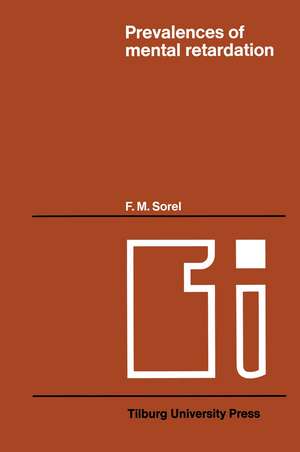Prevalences of mental retardation: Tilburg Studies on Health Care, cartea 3
Autor F.M. Sorelen Limba Engleză Paperback – 6 noi 2011
Preț: 379.86 lei
Nou
Puncte Express: 570
Preț estimativ în valută:
72.69€ • 75.10$ • 60.47£
72.69€ • 75.10$ • 60.47£
Carte tipărită la comandă
Livrare economică 19 martie-02 aprilie
Preluare comenzi: 021 569.72.76
Specificații
ISBN-13: 9789401019705
ISBN-10: 9401019703
Pagini: 160
Ilustrații: 154 p.
Dimensiuni: 152 x 229 x 8 mm
Greutate: 0.22 kg
Ediția:Softcover reprint of the original 1st ed. 1974
Editura: SPRINGER NETHERLANDS
Colecția Springer
Seria Tilburg Studies on Health Care
Locul publicării:Dordrecht, Netherlands
ISBN-10: 9401019703
Pagini: 160
Ilustrații: 154 p.
Dimensiuni: 152 x 229 x 8 mm
Greutate: 0.22 kg
Ediția:Softcover reprint of the original 1st ed. 1974
Editura: SPRINGER NETHERLANDS
Colecția Springer
Seria Tilburg Studies on Health Care
Locul publicării:Dordrecht, Netherlands
Public țintă
ResearchCuprins
1. Introduction.- 1.1. General.- 1.2. Some remarks for the benefit of the non-dutch reader.- 2. Survey of the Mentally Handicapped: Background, Preparation, Plan and Execution.- 2.1. A problem of policy.- 2.2. The preparation of the investigation.- 2.3. The plan and course of the investigation.- 2.4. Education of some essential decisions taken in the investigation.- 2.5. What was not investigated.- 2.6. The prevalence study as part of a larger project.- 2.7. Organization and financing.- 3. Definitions.- 3.1. The definition of mental retardation in general.- 3.2. The psychological criterion.- 3.3. The criterion of age.- 3.4. The sociological criterion.- 3.5. The definition of mental Retardation: Conclusion.- 3.6.‘Amsterdam’, ‘intra-mural’ and ‘extra-mural’.- 4. The Prevalence Found as a Result of Tracing and Individual Examination.- 4.1. Introduction.- 4.2. Registered mental retardation.- 4.3. The relation between registered and defined mental retardation.- 5. The Assessment of the Prevalence of Retardation within the Groups of Pupils Aged 10 and 13 Years.- 5.1. Introduction.- 5.2. The administrative tracing.- 5.3. The individual examination: those examined and those not examined.- 5.4. Applying the psychological criterion.- 5.5. Applying the sociological criterion.- 5.6. GLO-debiles.- 5.7. Summary.- 6. The Assessment of the Prevalence of Mental Retardation Among Adults.- 6.1. Introduction.- 6.2. A broad outline of the tracing procedure.- 6.3. Results.- 6.4. The prevalence of mental retardation.- 6.5. Criticism of the assessment of the prevalence of retardation.- 7. A Comparative Analysis of Prevalence Studies.- 7.1. Introduction.- 7.2. The investigation by lewis.- 7.3. Other prevalence studies on mental retardation.- 7.4. The Amsterdam study of theprevalence of mental retardation and the others.- Summary of 17 Prevalence Studies.- Summary.














